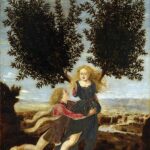![Misty_Woods_by_NerghaL[1]](http://jeanraffa.files.wordpress.com/2010/05/misty_woods_by_nerghal1.jpg?w=200) I spent the first half of my life in a mist, blind to all that is sacred. A spiritual seeker from the age of 17, my ideas about what was sacred came from other people. Only very rarely did I actually experience the sacred. But then I discovered the symbolic meaning in dreams and myths. Myths are cultural expressions of humanity’s relationship to the gods. While not necessarily true on the outside, myths are always true on the inside because they address the truths of the soul. Dreams are personal myths. Allowing ourselves to be led by mythos thinking helps us grow our spirits and recover our souls.
I spent the first half of my life in a mist, blind to all that is sacred. A spiritual seeker from the age of 17, my ideas about what was sacred came from other people. Only very rarely did I actually experience the sacred. But then I discovered the symbolic meaning in dreams and myths. Myths are cultural expressions of humanity’s relationship to the gods. While not necessarily true on the outside, myths are always true on the inside because they address the truths of the soul. Dreams are personal myths. Allowing ourselves to be led by mythos thinking helps us grow our spirits and recover our souls.
In A History of God, former nun Karen Armstrong says, “The only way we can conceive of God, who remains imperceptible to the senses and to logical proof, is by means of symbols, which it is the chief function of the imaginative mind to interpret.” And in The Holy Longing, Jungian analyst Connie Zweig writes, “In effect, the life of the imagination is the spiritual life.”
Three months after I began to practice dreamwork I was staying at the beach when I had dream #46. I called it “Temple in the Wilderness.”
I walk through woods on a path cut through the earth. I’m seeking a stream I know to be at the bottom. I find it where it spills into the sea and follow it to a mist-shrouded garden. In it are ruins of a Greek temple; one column remains upright. In awe, I kneel to examine some creamy-white flowers. Near the bottom of the plant is a pyramid-shaped arrangement of four glowing, waxy white horses facing the four directions. Surrounding them are blossoms so beautiful I can hardly take them in. A puppy named Prince playfully grabs my hand, inviting me to follow him. A young woman asks his name and is pleased to hear it. Two other people bring food for the puppy. After seeing a couple walking hand-in-hand through the distant mist I awaken.
I found this dream profoundly moving, which is how I knew it was important. I won’t go into my associations for the symbols of path, woods, stream, sea, garden, Greek temple, column, mist, kneeling, white flowers, glowing horses, the four directions, the puppy Prince who wants to guide me, the people who feed him, or the couple walking through the mist. But when I awoke I felt as if a cold, hard place in my heart was softening, melting down, and warming up.
The body remembers. To honor this feeling so I would never forget it I made a ritual that morning of walking down to the beach with an ice cube in my hand. Kneeling in the sand, I held it in the warm salty water until it melted. After that I deepened my study of symbolism and myths. Two years later I redesigned my dining room to remind me of the misty temple in the woods and began working on a manuscript which became The Bridge to Wholeness. That first book about the inner life opens with an original myth that is a metaphor for my spiritual journey.
As author and spirit warrior William Horden has said, “to those of us attuned to the one psyche, no one can fool us into thinking we are just indulging in our ‘imagination’. We have had a taste of the ever-new bubbling fountain of creation…from that point on, for the intoxicated soul thirsty for more of the gods’ nectar, there is only the creative act…the ‘making’ that reveals the artist within each of us.”
With each imaginative, creative act we make to honor the truths bubbling up from our source we re-myth our lives. To live our own myth is the authentic, soul-satisfying sacredness awaiting us beyond the mist.

The Poison of Misogyny: Part III
In August of 1942, Walt Disney released the classic animated film, Bambi. When it was rereleased some years later, my mother took me on a





0 Responses
I’d love to see that dining room!
I’ll describe it for you: The walls are faux painted to feel like a marble temple, there are two columns holding up an entablature in front of a bay window, the curtains are a thin white gauzy linen, the ceiling is painted to look like the sky, and the art is suggestive of Greek myth. It’s lovely and always brings back the feeling of that sacred space in the misty woods.
Reblogged this on The Highly Sensitive Family.
Thank you. Jeanie